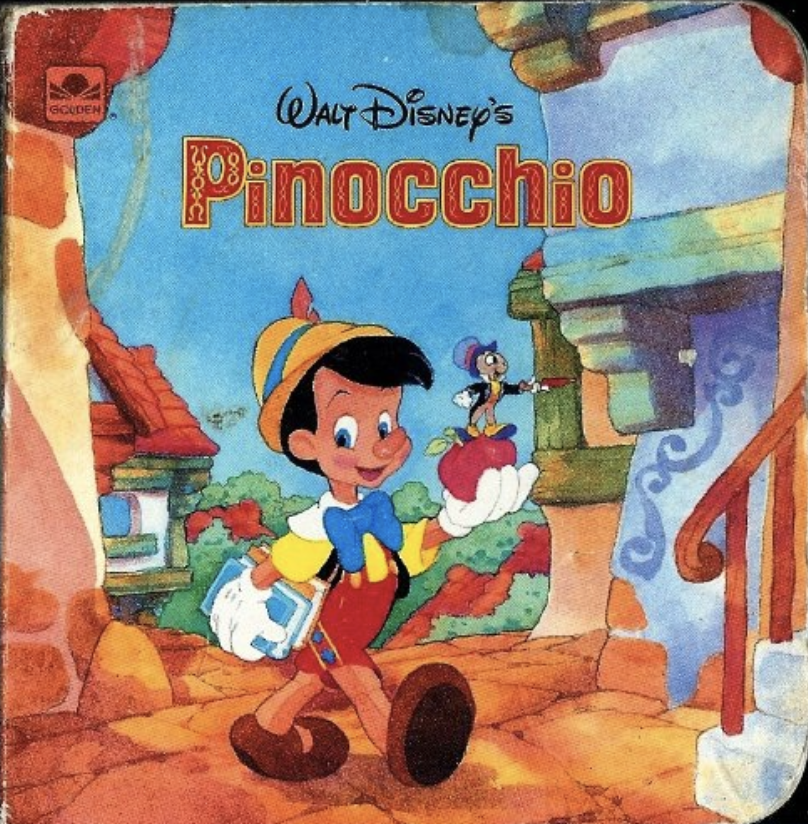Pinocchio
Book Module Navigation
Summary
Carlo Collodi’s Pinocchio addresses questions of personhood, right and wrong, lies, and redemption.
Geppetto wishes every night for a son, and his wish is granted when the Blue Fairy makes Geppetto’s new puppet, Pinocchio, come alive. Not understanding the responsibilities that come with being a real boy, Pinocchio finds himself trapped by a theatre manager and turning into a donkey when he doesn’t go to school. Worried about where Pinocchio has gone, Geppetto searches for him and ends up starving in the belly of a whale. Pinocchio eventually finds his father and rescues him and the Blue Fairy turns Pinocchio into a real boy.
Read aloud video by The Reading Unicorn
Guidelines for Philosophical Discussion
Pinocchio tells the story of a young boy who has recently been introduced to the real world. Pinocchio is ecstatic for the chance to be a real boy, and wants to be a good boy for his father while having lots of fun along the way. Instead of going to school, Pinocchio decides to be an actor, but is captured by the evil Stromboli before the Blue Fairy helps him to escape. Not having learned his lesson, he then finds himself befriending a boy named Lampwick, who encourages Pinocchio to smoke cigars and eat lots of junk food. Pinocchio faces many moral dilemmas as he weighs responsibility with pleasure, which fills Pinocchio with many questions for philosophical discussion. The book addresses issues such as lying, personhood, redemption, and right vs wrong.
Children often tell lies in order to stay out of trouble. Sometimes they struggle with the guilt of knowing they did something wrong. Children also frequently experience being lied to. Eventually, they learn that value of the truth, even if telling the truth means getting in some trouble. Pinocchio’s nose grows a little bit every time he tells a lie. It is a comical way to explore lying and gauge how children understand the subject in their own lives.
Geppetto wants to have a real boy. Pinocchio wants to be a real boy. The phrase “real boy” is brought up a few times throughout the Pinocchio story, but what constitutes a real boy is not discussed. Children can explore what it means to be “real” by discussing Pinocchio’s realness. Perhaps because he is alive, Pinocchio is a real boy. Maybe he is only a real boy at the end when he is no longer made of wood. Children can analyze what it is that makes them real, and what’s more, what makes them them. They can assess their own traits and define what it means to be real. Through evaluation of their own personhood, children can talk about what makes someone a person and how these traits can change depending on the situation.
Pinocchio makes some bad decisions in this story. He skips school to become an actor, and later to go to Pleasure Island, where no one can tell him what to do. He faces the consequences, though, and is jailed by his theater manager and starts to turn into a donkey at Pleasure Island. Despite these bad decisions, we root for Pinocchio to make the right decision next time as opposed to seeing him as a bad kid. Children can reflect on these feelings and the concept of redemption, where just because some bad decisions were made does not make someone unredeemable. Even though Pinocchio skipped school because of bad influences, he still got to become a real boy in the end, and children can discuss whether or not he deserved this reward.
Pinocchio, who is new to the world and the idea of right and wrong, must struggle through many choices. Children often give into what they want instead of what they need and struggle to listen to their parents and teachers sometimes. Children can easily identify with Pinocchio and his troubles. Children watch Pinocchio as he makes mistakes but learns from them and strives to do better next time. They can use Pinocchio to discuss the fact that everyone makes mistakes and it does not necessarily make you a bad person for doing so. Children can also gain a better understanding of the silver lining to making mistakes as a good way of learning right from wrong.
Questions for Philosophical Discussion
Lying
- Why does Pinocchio lie to the Blue Fairy?
- Have you ever told a lie? How did it make you feel?
- Have you ever been lied to? How did it make you feel?
- Is there anything you do when you lie, like how Pinocchio’s nose grows? Do you play with your hands? Look around the room?
- Is it better to tell the truth than to tell a lie?
- Why is it not okay to lie?
Personhood
- What does it mean to be a “real boy” (or girl)?
- At what point in the story was Pinocchio real?
- (If they say Pinocchio was only real at the end) If Pinocchio could walk and talk, how could he not be real?
- What qualities make you real?
- What qualities make you who you are?
- Do you feel like there are different versions of yourself (you at home vs you in class vs you with your friends)?
Right and Wrong
- Did Pinocchio make all of the right choices?
- Who was there to teach Pinocchio right from wrong?
- Why did Pinocchio skip school the second time after he got himself into trouble the first time?
- Do you think Pinocchio had bad intentions? Why did he make the wrong choices?
- How did Pinocchio learn right from wrong in the story?
- Have you ever made a mistake? What did you learn from that mistake?
- Is it okay to make mistakes sometimes? What can we gain from making mistakes?
Find tips for leading a philosophical discussion on our Resources page.







